Excerpts from Jim Conrad's
Naturalist Newsletter
entry dated August 14, 2022, issued from near Tequisquiapan, elevation about 1,900m (6200 ft), N20.565°, W99.890°, Querétaro state, MÉXICO
MEXICAN DOCK
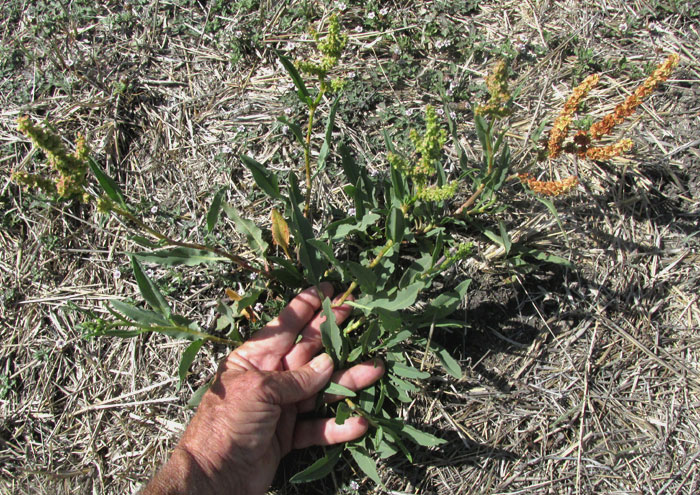
The above plant occurred at the edge of a large, flat field in a little valley that sometimes floods during the rainy season, and most years is planted in corn at this time. However, this year the rainy season hasn't arrived, so the field is lying fallow. The plant was both very familiar, and different. It was familiar because with its growth form and few-branched panicles loaded with tiny flowers and cluttered fruits turning brown, it's obviously what's called dock in English, genus Rumex. However, it's not the famous Curly Dock which during my years up north I so frequently ate well buttered and with cornbread. This is a smaller species with smooth, not curly, leaves, as shown below.
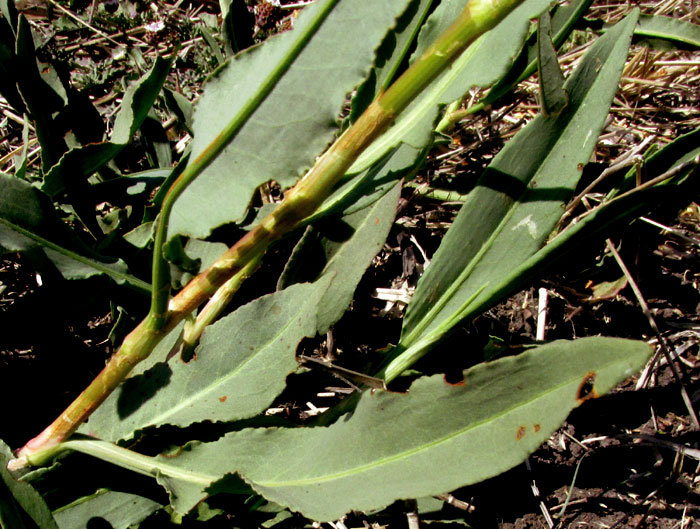
These leaves are paler than Curly Dock's, too. Many plants produce such simple-shaped leaves, so if you want to be sure you have a dock, which belongs to the Buckwheat Family, the Polygonaceae, look for the "ocrea." Ocreas sometimes are called stipular sheaths. They occur where leaf bases, where they reach the stems, form a cylindrical structure wrapping around the stems. The ocreas may extend a little above the point of attachment, and below the point they end at the first joint, or node. One of this plant's ocreas is shown below:
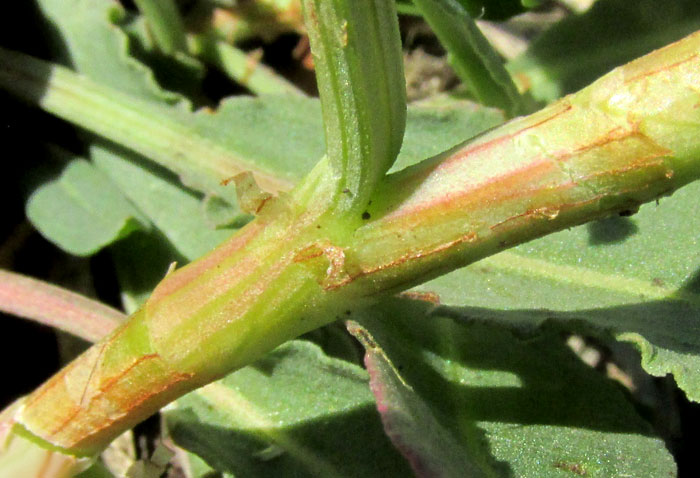
The ocrea is the part looking like thin cellophane with faint, brownish ribs running longitudinally. When leaves and shoot tips are first emerging, the ocreas wrap around them, protecting the sensitive young tissue. The ones in the picture are remnants of that time, plus they still may be providing a little stiffness to the stem.
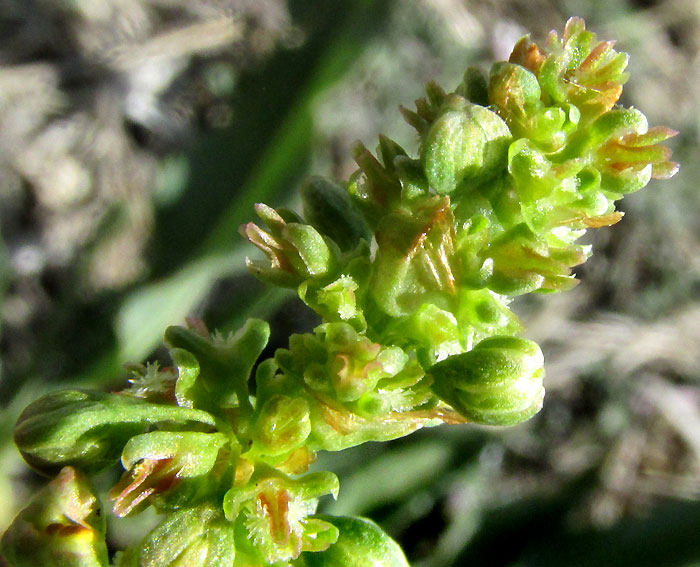
Dock flowers are tiny. They open at the tips of cluttered inflorescence branches, as seen above. In that picture, several flowers haven't yet opened, each roundish flower bud covered with six overlapping tepals. Tepals are what you call calyx and corolla lobes when they are indistinguishable from one another. In Dock flowers, all six tepals look like green sepal lobes.
In the above picture some flowers are open. Each flower produces six stamens, whose cream-colored, pollen-producing anthers look like tiny split bananas in the image. Atop each ovary arise three styles and stigmas. The stigmas are feathery, exposing lots of surface area for collecting pollen grains from the air. Some stigmas, which are white, are visible in the picture's lower, left corner.
The plant must have produced an earlier flowering, because among the green, flowering inflorescences were a few brown, dried-out ones bearing maturing fruits. A close-up of one of those inflorescence branches appears below:
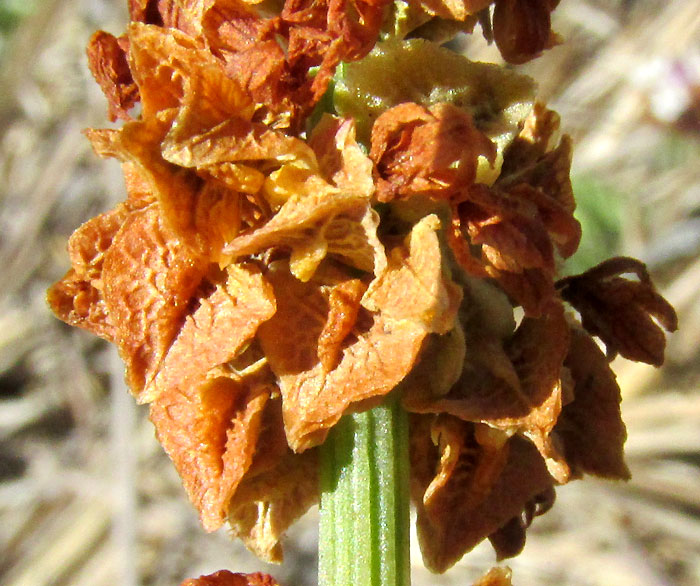
A dock fruit consists of a grain-like seed surrounded by a broad, more-or-less triangular, papery, veiny, winglike tepal. In the above picture, the easiest to see tepal bearing a seed is at the top of the visible part of the green rachis. That tepal is attached at its base to two other of the original flower's tepals, forming a three-sided structure a little like a pyramid. Below, several fruits are shown loose in the palm of my hand, each tepal's venation reminding us of the Tree of Life:
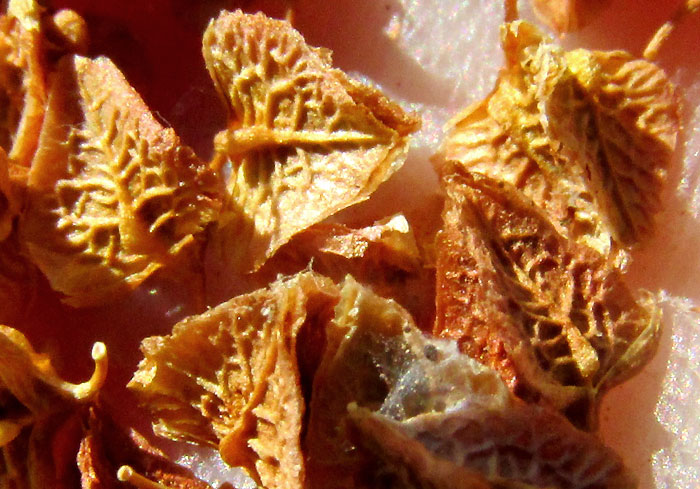
As many as 200 species of the genus Rumex are recognized, distributed almost worldwide, and predominantly in temperate regions of both hemispheres. Certain species are better known as sorrels instead of docks. In North America about 63 Rumex species are documented, but in our Bajío region of semiarid, upland central Mexico only five have been documented. Curly Dock is here, invasive from Eurasia. In fact, only one of our five species is native to this region, and that one is easy to distinguish from the other species because neither its leaves nor the tepals surrounding its fruits are toothed, but rather smooth-edged -- exactly like our plant's. And our plant is that one, the Mexican Dock, RUMEX MEXICANUS.
Mexican Docks are distributed from southern New Mexico in the US south throughout Mexico into Guatemala, mostly in grasslands and cultivated areas, at a wide range of elevations. Possibly they're invasive well beyond that area, but their taxonomy isn't settled and it's hard to say. What seems like a widely distributed species may end up as several distinct species.
Like other docks and sorrels, Mexican Dock is edible, either cooked or, in small amounts, in fresh salads. They contain high concentrations of acid-tasting oxalates, which mostly but not entirely are destroyed by cooking. Mexicans call all the dock species lengua de vaca, or "cow's tongue," and when they speak of eating lengua de vaca usually they're speaking not of their native Mexican Dock but of the invasive Curly Dock. In some literature Curly Dock is described as a traditional herb, but it's traditional only back to the times of the Spanish invasion. Mexican Dock probably is as flavorful as Curly Dock, but it's smaller.
By the way, plants containing high levels of oxalates benefit by the role calcium oxalate plays in regulating the body's calcium concentration. Oxalates enable plants to live in acid soils where aluminum toxicity may be a problem. Oxalates are a problem with humans, though, because our bodies can't degrade them. About 85% of all kidney stones contain calcium oxalate in some proportion.
The literature mentions that Mexican Dock taproots contain fair levels of tannin, which can be used as a brownish dye. Here dock roots have been used to color textiles, coffee and tortillas.
Mexican Dock's Etnobotánica Mexicana webpage says that traditionally the root has been used for chronic constipation, diarrhea, anemia and more. The main popular use, though, is to take advantage of its roots' astringent tannin, which makes flesh pucker and stop bleeding.
The plant name "dock" goes way back. In Old English it was docce, which came by way of the Proto-Germanic dokkon, used to refer to various tall, coarse weeds or herbs.